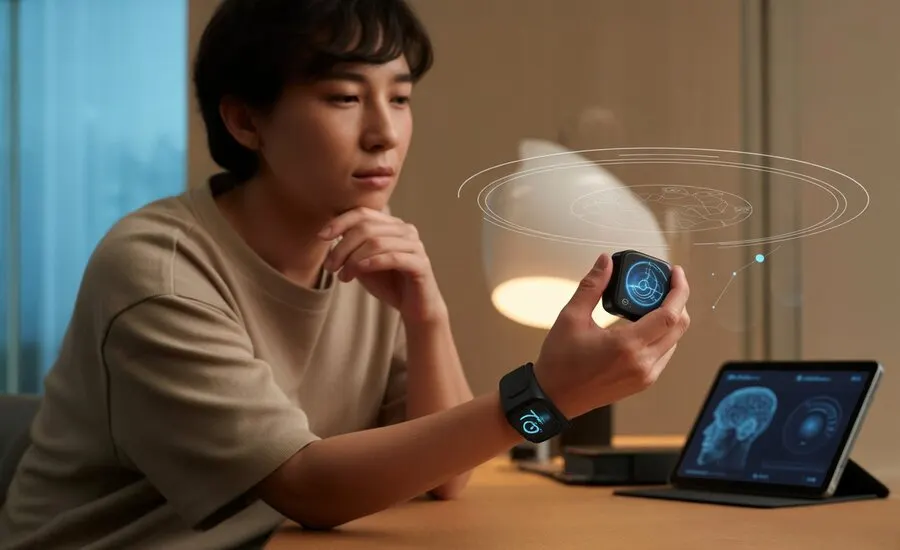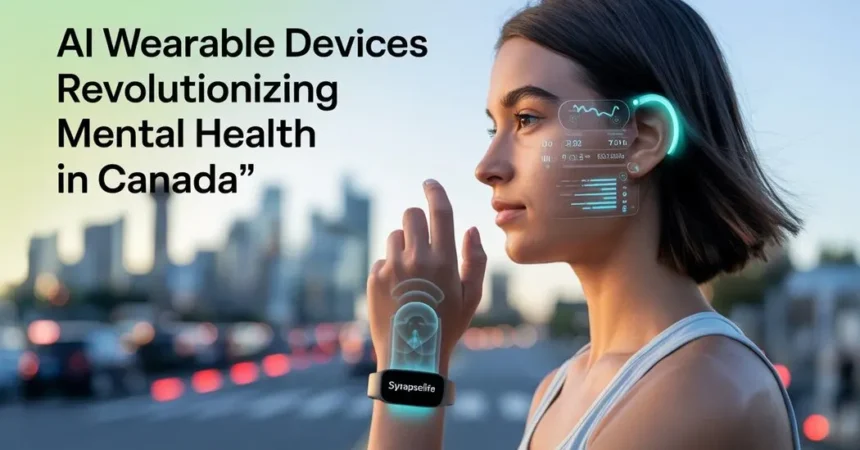Ever had one of those days where stress just won’t quit? Maybe you’re stuck in Toronto traffic or shoveling snow in Winnipeg. In Canada, one in five of us faces mental health struggles every year. That’s a ton of folks, eh? But here’s the cool part: AI wearable devices are swooping in to help. These nifty gadgets track your mood and dish out tips to keep you calm. Plus, Canada’s killing it in the AI game. In 2025, these devices are making mental health care personal, easy, and downright awesome.
So, grab your coffee, and let’s dive into how AI-powered wearable devices are changing lives from coast to coast.
The Mental Health Landscape in Canada
Mental health’s a big deal up here. The Canadian Mental Health Association says 20% of us deal with anxiety or depression yearly. That’s one in five neighbors, coworkers, or that guy at the Tim Hortons drive-thru. Moreover, the pandemic threw us for a loop. Working from home, missing friends—it got heavy. Picture a Vancouver nurse juggling night shifts and Zoom calls with her kids. Yikes, right?
Thankfully, Canada’s stepping up. In 2023, the feds promised $4.5 billion for mental health programs. As a result, telehealth apps like Maple are booming. Meanwhile, hockey stars and singers are opening up about their struggles. It’s making mental health chats less taboo. However, places like rural Nunavut still lack clinics. That’s where AI wearable devices shine, bringing help to every snowy corner of our country.
Understanding AI Wearable Devices for Mental Health

So, what’s an AI wearable device? Think of a stylish smartwatch or a cozy headband that’s got your back. These gadgets track stuff like your heart rate or how well you slept. Then, AI works its magic, spotting when you’re stressed. For instance, it might nudge you to take a deep breath during a crazy work call. Talk about a lifesaver!
Here in Canada, we’re leading the pack. Take Muse, a headband from Toronto’s InteraXon. It tracks your brain waves to make meditation a breeze. Plus, 2025’s bringing new gear, like MindTrack Innovations’ stress-busting wristbands. They send tips right to your phone, fitting into your life—whether you’re grabbing poutine in Montreal or cramming for exams in Halifax.
How Do They Work?
- Track Data: Sensors monitor heart rate, sleep, or stress, giving real-time insights into your mood while you hustle daily.
- AI Magic: Smart algorithms crunch biometric data to spot anxiety or fatigue, tailoring insights for your mental health journey.
- Instant Tips: Your phone pings with ideas like “Try a quick stretch!” to chill you out during hectic moments.
- Custom Care: Get personalized meditation or sleep tips, perfect for late-night study sessions or long winter workdays.
Best AI Wearables for Stress in Canada
AI wearable devices are total game-changers. They’re like a friend who knows when you’re stressed. Picture a Calgary student sweating over finals week. Her wearable catches her racing heart. So, it suggests a quick mindfulness break. That’s help tailored just for her, eh?
Plus, these devices bring care everywhere. In rural Manitoba, therapists are hard to find. But a wearable works on a farm or in a small town. For example, a Saskatchewan dad uses one to stay calm during harvest chaos. Also, AI wearable devices hook up with telehealth apps like Teladoc. You can chat with a doctor while sipping tea at home.
Workplace Wins
Burnout’s a real problem, especially in Canada’s tech hubs. But companies are fighting back. For instance, a 2024 Toronto pilot gave workers stress-tracking bands. The result? Everyone felt calmer, and sick days dropped 15%. One employee laughed, “My watch knows when I need a breather before I do!” That’s tech making work feel less like a grind.
Real-Life Stories
- Busy Parents: A Halifax mom uses her wearable to tame anxiety during her kids’ wild hockey season, finding peace daily.
- Students: A UBC student tracks sleep to stay sharp, dodging exam stress with her wristband’s clever sleep tips.
- Indigenous Communities: Wearables help remote First Nations folks access mental health support, closing gaps in Canada’s far north.
- Nurses: A Montreal nurse relies on her stress tracker during night shifts, getting tips to stay cool under pressure.
Canadian Innovations Driving AI Wearable Technology
Canada is a rockstar in health tech. Take InteraXon’s Muse headband—it’s a global hit for meditation. Meanwhile, Vancouver’s MindTrack Innovations is dropping affordable AI wearable devices in 2025. These are built for every budget, from students to retirees.
Plus, our AI hubs are buzzing. Montreal’s Mila is diving into healthcare AI. Toronto’s Vector Institute backs wearable projects. Also, the government poured in cash —$200 million in 2024 alone. As a result, Canadian devices are popping up in Japan and Germany. A Mila researcher grinned, “We’re building mental health tools the world loves.”
Key Innovators
- InteraXon: Toronto’s meditation tech champ, with Muse headbands using brain-wave tracking to help users find calm daily.
- MindTrack Innovations: Vancouver startup crafting budget-friendly stress trackers for 2025, making wellness accessible for all Canadians.
- Mila and Vector: Montreal and Toronto hubs drive AI breakthroughs, partnering with startups for cutting-edge wearable health solutions.
- Waterloo Tech: Waterloo’s startups build sleep-tracking wearables, boosting Canada’s rep as a global health tech leader in 2025.
Challenges and Ethical Considerations
Okay, AI wearable devices aren’t perfect. Privacy’s a huge worry. These gadgets collect your heart rate or sleep data. What if someone hacks it? Canada’s PIPEDA law keeps things tight. Still, companies gotta stay sharp to protect us.
Also, rules are changing. The Artificial Intelligence and Data Act (AIDA) makes sure AI plays fair. For instance, it demands clear data use. That builds trust. But cost’s a problem. Some devices run $300 or more. So, low-income folks might miss out. Thankfully, startups are working on cheaper options.
Lastly, AI bias is real. If algorithms skip Indigenous or minority data, they might mess up. Thus, developers are pushing for inclusivity. A Toronto techie said, “We’re making sure tech works for every Canadian.”
Key Challenges
- Privacy: Protecting heart rate or sleep data from hackers is critical, as users share sensitive info every day.
- Affordability: High prices lock out low-income Canadians, but 2025 startups aim for budget-friendly wearables for all.
- Bias: AI must include diverse groups, like Indigenous communities, to avoid errors and ensure fair mental health support.
- Rules: AIDA balances innovation and ethics, demanding clear data practices to keep user trust in wearable tech.
The Future of AI Wearables in Canada’s Mental Health Ecosystem
What’s next for AI-powered wearable gadgets? By 2025, they’ll be tiny and wicked smart. Imagine earbuds with VR for therapy sessions. Plus, AI will predict stress before it hits. For example, your device might warn you before a panic attack during a stormy Edmonton commute.
Also, Canada’s healthcare might jump in. Ontario could fund wearables for patients, like free therapy apps. Canadians are stoked too—X posts are buzzing with excitement. Globally, we’re leading the charge. A Vancouver founder said, “We’re making wellness as easy as checking your pulse, eh?”
What’s Coming?
- Smarter AI: Algorithms predict stress or mood shifts, offering proactive tips to avoid mental health crises every day.
- Healthcare Ties: Ontario may fund wearables, linking them to clinics for seamless mental health support across Canada.
- Budget Options: Affordable devices allow everyone from students to seniors to access wellness tech, making mental health care more inclusive by 2025.
- VR Therapy: VR wearables offer at-home therapy, transforming mental health care in Canada’s cities and rural areas.
Conclusion
Bottom line? AI wearable devices are shaking up mental health in Canada. They’re personal, reachable, and powered by our innovation. From Yukon’s snowy trails to Montreal’s bustling cafes, they’re helping us feel better. Sure, privacy and cost need work, but 2025 looks bright. So, give Muse a try or follow startups on social media platforms. Let’s make mental health a priority—because we’re all in this together.
FAQs
What are AI wearable devices for mental health?
AI wearable devices are gadgets like smartwatches that track heart rate or sleep. For instance, AI spots stress fast. Then, it sends tips like breathing exercises. In Canada, Muse helps with meditation. So, it’s like a pal keeping you calm, eh?
How do AI wearables help Canadians with stress?
These devices tackle stress like champs. Specifically, they catch a racing heart. For example, a Halifax student gets a “Chill!” alert. Moreover, they suggest mindfulness tips. As a result, Canadians manage stress anywhere. Pretty cool, right?
Are AI wearable devices safe to use in Canada?
Safety’s key. However, AI-powered wearable gadgets follow Canada’s PIPEDA laws. For instance, your data stays secure. Still, companies fight hacks. Additionally, AIDA ensures ethical AI. So, you can trust these gadgets.
Can rural Canadians access AI wearables for mental health?
Yes, rural access rocks. In Nunavut, therapists are rare. But AI wearable devices work anywhere. For example, a farmer gets stress tips. Plus, they link to telehealth apps. Thus, care reaches everyone.
How affordable are AI wearable devices in Canada?
Cost’s a concern. Some devices hit $300. However, startups like MindTrack offer budget options. For instance, 2025 models are cheaper. So, more Canadians can afford them. That’s a win, eh?
Do AI wearables work for all Canadians?
Inclusivity matters. But AI might miss Indigenous or minority data. For example, algorithms need diverse inputs. Thus, developers focus on fairness. As a result, wearables help everyone better.
What’s the future of AI wearables in Canada?
The future’s bright. By 2025, AI-powered wearable devices will be smarter. For instance, VR therapy earbuds are coming. Plus, provinces might fund them. So, mental health care will soar.



